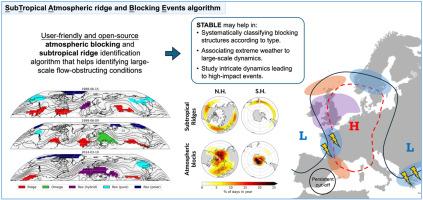STABLE: An open-source atmospheric blocking and subtropical ridge detection system
IF 4.6
2区 环境科学与生态学
Q1 COMPUTER SCIENCE, INTERDISCIPLINARY APPLICATIONS
引用次数: 0
Abstract
The SubTropical Atmospheric ridge and BLocking Event (STABLE) algorithm is an open-source Python-based tool for the tracking of high-pressure systems, distinguishing between subtropical ridges and types of atmospheric blockings. The output includes 2-D daily spatial structures allowing the spatio-temporal tracking of high-pressure events, as well as compiled statistics of their characteristics. Building upon state-of-the-art geopotential gradient methodology, STABLE introduces customizable changes to refine the structure identification and classification, improve usability, and extend the algorithm's adaptability. Key inclusions are a zonally varying subtropical boundary, refined criteria for polar blocking, and an advanced classification scheme for hybrid blocking events. Validation with reanalysis data for the 1991–2020 period demonstrates STABLE's ability to capture high-pressure events and improved accuracy while preserving replicability of earlier results. STABLE offers a user-friendly framework for customizable studies focusing on atmospheric dynamics and climate variability, historical trends and future projections or region-specific impact assessments.

STABLE:一个开放源码的大气阻塞和副热带高压脊探测系统
副热带大气脊和阻塞事件(STABLE)算法是一个基于python的开源工具,用于跟踪高压系统,区分副热带脊和大气阻塞类型。输出包括二维日常空间结构,允许对高压事件进行时空跟踪,以及对其特征进行编译统计。基于最先进的地势梯度方法,STABLE引入了可定制的更改,以改进结构识别和分类,提高可用性,并扩展算法的适应性。关键包裹体包括一个纬向变化的副热带边界、极地阻塞的精确标准和混合阻塞事件的高级分类方案。1991-2020年期间的再分析数据验证表明,STABLE能够捕获高压事件,并在保持早期结果可复制性的同时提高准确性。STABLE提供了一个用户友好的框架,用于侧重于大气动力学和气候变率、历史趋势和未来预测或特定区域影响评估的可定制研究。
本文章由计算机程序翻译,如有差异,请以英文原文为准。
求助全文
约1分钟内获得全文
求助全文
来源期刊

Environmental Modelling & Software
工程技术-工程:环境
CiteScore
9.30
自引率
8.20%
发文量
241
审稿时长
60 days
期刊介绍:
Environmental Modelling & Software publishes contributions, in the form of research articles, reviews and short communications, on recent advances in environmental modelling and/or software. The aim is to improve our capacity to represent, understand, predict or manage the behaviour of environmental systems at all practical scales, and to communicate those improvements to a wide scientific and professional audience.
 求助内容:
求助内容: 应助结果提醒方式:
应助结果提醒方式:


